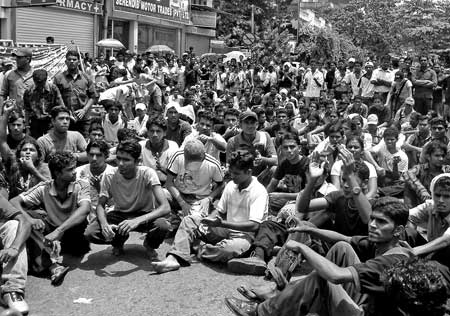
Violence: Sixth factor of production in an economy?
I was in the habit of having tea with a group of undergraduates regularly at the cafeteria. They used the opportunity to discuss, among themselves, many issues of economics and politics. My role was to moderate it and intervene, if necessary, to re-rail any de-railed discussion. “The level of violence in modern societies is on the increase,” one undergraduate remarked. “It has come to a level that no one is safe today. I’m angry because I can’t do anything about it.” “It’s true,” another joined in. “Violence is eating into our lives.” “Economists look at violence from a different point of view,” I said. “For them, violence is an inevitable input which a society has to use when undertaking any activity, not necessarily economic activities. Society, like you guys, doesn’t like it. But, it has no choice. It drives all activities through violence. Some even have categorised it as the sixth factor of production, just like land, labour, capital and enterprise and the latest addition as the fifth, environment.” They could not understand the logic of my argument. So, they all cast a puzzling look at me. “Violence is simply the mental and physical pain which one would inflict either on himself or on someone else,” I began my explanation. “Without causing mental and physical pain, we can’t do even a very simple activity. For example, take the case of reading a book. You’ve to strain your mind and body to do that. When you strain them, it causes pain and that pain causes suffering. So, its violence you have inflicted on yourself.” “But, the type of violence we talk about is different. That’s the pain which one person inflicts on another. That’s a social disease,” a student argued. “It happens when we get others to work. Suppose I hire one of you guys to work for me. There, I have to inflict violence on you. I may threaten that if you don’t do the job as I expected, I would fire you. It causes fear in you and that fear causes mental pain. Again when you actually work for me, you strain your physical body causing pain again. So, because of the violence I unleashed on you, you unwillingly strain your body. But, if I don’t use violence, you don’t work properly. So, what you’ve been driven is nothing but violence.” “But, can’t we get people to work by offering them incentives, instead of threatening them?” a girl said, countering my argument. “You can get people to work through incentives. But, it would free you only of the mental pain caused by fear which I’d have inflicted. You still have to strain your physical body to deliver the output. If the work is rather difficult and challenging, it causes mental stress as well leading to pain. So, what has happened is that, instead of my unleashing violence on you, you’ve chosen to do it by yourself. It doesn’t matter whether violence is inflicted by someone else or by yourself. It’s still violence,” I explained to them. “If violence is inevitable and necessary, then, what’s wrong with it?” one of the students asked. “Violence, whether it’s self-inflicted or not, causes pain and pain causes stress. If stress is not properly managed, it leads to a wide array of destructive mental conditions like mild to severe depression and sometimes, more serious illnesses like paranoia or schizophrenia. When the labour force is mentally sick like that, it reduces productivity and adversely affects economic well-being,” I said. “You mean to say that we’ve to contend with violence as an inevitable happening?” one of the students inquired. “No,” I said. “Violence is bad. But, fortunately, there are social safeguards that allow the violence produced in the society to get itself dissipated without causing a major break-down. You’ve problems only when these social safeguards are not permitted to function.” “How interesting? Can you explain them?” the same student asked. “They’re of four types,” I began to explain. “One is social safety valves. They release the excess pressure built in the society. Good examples are drinking and gambling. One may add sexual activities also. Unfortunately, all these safety valves have been termed as evils and society tries to control them. Then, you’ve social shock absorbers. One good example is loved ones. Another is family. It absorbs your stress. Another type is social fuses. Like any other fuse, it kills itself to save society from a bigger damage. The final one is social cooling systems. They don’t allow the system to over-boil and explode. You’ll see that they all are similar to the protective mechanism that you find in a motor car engine. If any one system malfunctions, the engine becomes non-functional. You’ve high level of violence, because you don’t permit the safety mechanism to function properly, because you term them to be evil or immoral. The result is that society is continuously over-boiling and that over-boiling is manifested in the form of violence, either inflicted on oneself like committing suicide or on others like homicide. It may come out purely as family violence or violence at the work place or as ethnic, religious or racial violence.” “What you say is that higher economic development breeds a higher level of violence?” one of the students remarked. “That’s right. Higher economic development means working harder. It causes greater stress and if we don’t permit the safety mechanism to function properly, it leads to a higher level of violence as well,” I said. |
|
||||||
|
||||||
| || Front
Page | News
| Editorial
| Columns
| Sports
| Plus
| Financial
Times | International
| Mirror
| TV
Times | Funday Times || |
| |
Reproduction of articles permitted when used without any alterations to contents and the source. |
© Copyright
2008 | Wijeya
Newspapers Ltd.Colombo. Sri Lanka. All Rights Reserved. |
